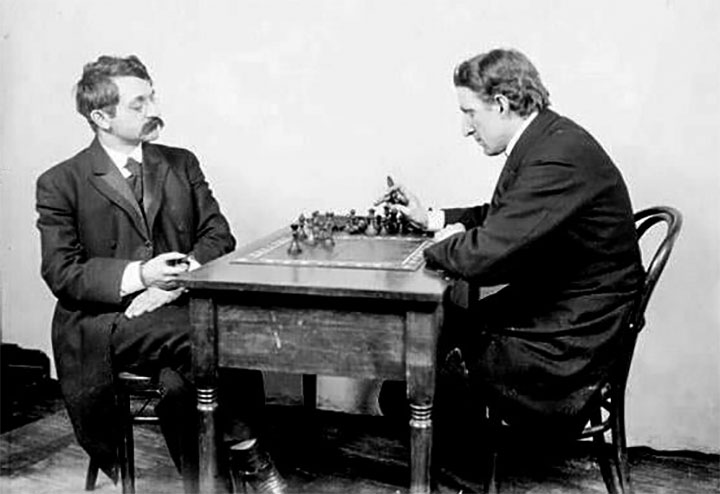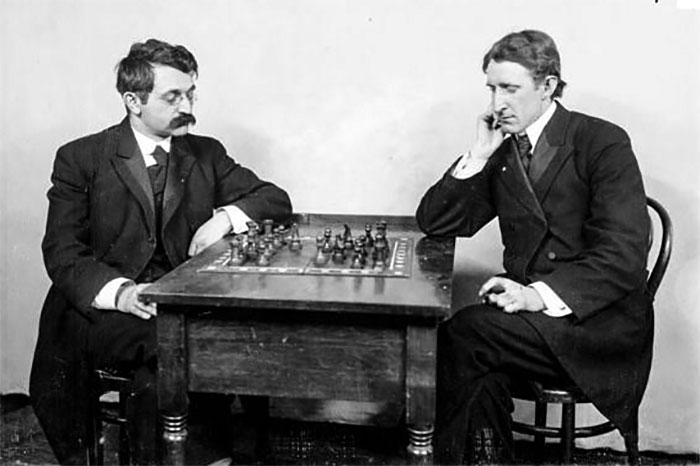Frank James Marshall was born on August 10, 1877 in New York City, though his early chess apprenticeship took place in Montreal, Canada, where he had moved to at age 8, and learned chess at the age of 10. Records can be found with his participation such as in 1893, when he was 15, where he came in third in the 1st Montreal Chess Club Championship. The following year, in 1894, he scored 50% in the 20th Canadian Championship, but by 1896 he was back at his homeland in New York, playing regularly.
It was in 1897 that he would score his first notable victory playing the Brooklyn Chess Club Championship that had hitherto been won by William Napier. To most readers, Napier’s name will mean little, but he was an exceptional talent in his own right and would even peak in the world’s Top 10 according to Chessmetrics. Napier had won the Brooklyn Chess Club championship in 1896 with 8.0/10 (Marshall was 3rd with 6½/10), but in 1897 both players were merciless in the 12-player round-robin as both scored 10/11. A playoff was organized and Marshall took it with 2.0/3.
"The hardest thing in chess is to win a won game." -- Frank Marshall
In 1900, he travelled to Paris to play in the International Tournament held there, bringing in the world’s greatest players of the age, such as Lasker, Pillsbury, Maroczy, Burn, Chigorin, Schlechter, Janowksi and more. The 17-player field was dominated by the World Champion Emanuel Lasker with a staggering 14½/16 (!!), with the American genius Harry Pillsbury in second with 12½/16, but Frank Marshall’s international debut was nothing less than sensational nonetheless as he came in clear third with 12.0/16, including individual wins over both Lasker and Pillsbury.
In 1904, he scored his greatest victory to date, taking clear first in the Cambridge Springs International Tournament with 13.0/15, two full points ahead of Lasker, and far ahead of other participating luminaries such as Janowksi, Schlechter, Chigorin, Pillsbury, and Teichmann. His place in the world’s chess pantheon was now well-established. Later that year he would also win the 7th American Chess Congress, but refused to accept the title for US Champion as the defending champion Pillsbury had not participated. Note that Pillsbury was deadly ill already and would die of syphilis in 1906. In fact, after Pillsbury’s death, Marshall still refused the title, and would only accept it after earning it in competition in 1909. He was to then hold the title for 27 years until 1936. This example of extreme fairplay and sportsmanship characterized him throughout his life. Even after losing a match to a Capablanca, not only did he show no resentment, but put in enormous effort to ensure the Cuban genius was given the best of opportunities.
Nevertheless, Marshall was to receive his own opportunity at the greatest title, when a match for the world championship was organized in 1907. The conditions were symptomatic of the time, and the winner would be the first player to win eight games. The match took place over a period of three months, with games played in New York, Philadephia, Washington DC, Baltimore, Chicago, and Memphis.

Emanuel Lasker faced Frank Marshall for the title in 1907, in a match that took place in several cities. This image was taken in the Chicago leg of the match | Photo: Chicago History Museum
Although Lasker was nowhere near as active as in his prime, in part due to his doctoral studies in mathematics, he convincingly showed he was still the greatest player of his day, defending his title in just 15 games, with eight wins, seven draws, and no losses.
The name Emanuel Lasker will always be linked with his incredible 27 years reign on the throne of world chess. In 1894, at the age of 25, he had already won the world title from Wilhelm Steinitz and his record number of years on the throne did not end till 1921 when Lasker had to accept the superiority of Jose Raul Capablanca. But not only had the only German world champion so far seen off all challengers for many years, he had also won the greatest tournaments of his age, sometimes with an enormous lead. The fascinating question is, how did he manage that?
Emanuel Lasker 1-0 Frank Marshall (1907) - Annotated by Garry Kasparov

[Event "World Championship 07th"] [Site "USA"] [Date "1907.01.26"] [Round "1"] [White "Marshall, Frank James"] [Black "Lasker, Emanuel"] [Result "0-1"] [ECO "C65"] [Annotator "Garry Kasparov"] [PlyCount "98"] [EventDate "1907.01.26"] [EventType "match"] [EventRounds "15"] [EventCountry "USA"] [SourceTitle "MainBase"] [Source "ChessBase"] [SourceDate "1999.07.01"] [SourceVersion "2"] [SourceVersionDate "1999.07.01"] [SourceQuality "1"] {Frank Marshall, the famous American player, was a fearless chess cowboy who at the first chance would rush into unpredictable complications. His aggressive style multiplied by youthful energy and natural optimism rewarded him with convincing victories in three big international tournaments. In 1904 at Cambridge Springs Marshall was first with the phenomenal result of +11, -0, =4, two points ahead of Lasker! Enthusastic American sponsors soon raised the money for Marshall to challenge Lasker for the World Championship title. But the crushing final score of this match, +8, -0, =7 in favour of Lasker, showed that both players belonged in different leagues.} 1. e4 e5 2. Nf3 Nc6 3. Bb5 Nf6 4. d4 exd4 5. O-O Be7 6. e5 Ne4 7. Nxd4 O-O 8. Nf5 d5 9. Bxc6 bxc6 10. Nxe7+ Qxe7 11. Re1 Qh4 12. Be3 f6 13. f3 {[#]} fxe5 $1 (13... Ng5 {was also playable, but Lasker makes a wise psychological choice. He knows that in the forthcoming complications after the piece sacrifice Marshall would feel more comfortable with the black pieces.}) 14. fxe4 d4 {I wonder whether Lasker calculated all the lines, but his intuition hasn't betrayed him. Black was not in danger of losing.} 15. g3 {A bishop retreat loses instantly:} (15. Bd2 $2 Bg4 16. Qc1 Rf2 $1 17. Bg5 Rxg2+ 18. Kxg2 Bh3+ 19. Kh1 Qf2 {with mate, or}) (15. Bc1 Qf2+ 16. Kh1 Bg4 {with the same result. }) 15... Qf6 16. Bxd4 $2 { Lasker's knowledge of human nature proved to be correct again. Marshall didn't want to face a strong attack, although Black's initiative was only enough to draw.} (16. Bd2 Qf2+ 17. Kh1 Bh3 18. Rg1 Bf1 $1 {Threatening Be2 and Bf3.} (18... h5 $2 19. Na3 Bg4 20. Rf1 $1) 19. Be1 Qe3 20. Nd2 Be2 21. Qc1 Bf3+ 22. Nxf3 Qxf3+ 23. Rg2 Qf1+ {with perpetual check.}) 16... exd4 17. Rf1 Qxf1+ 18. Qxf1 Rxf1+ 19. Kxf1 {Clearly, when Marshall decided to avoid all dangers posed by 16. Bd2 he thought that this endgame was clearly drawn. But Lasker had a different opinion. Now enjoy his endgame magic!} Rb8 $1 20. b3 Rb5 $1 { [#]} 21. c4 $2 {Marshall's fantasy was lost in the endgame desert. His radical solution to the weakness of the pawn on c2 was a serious positional mistake.} ( 21. c3 $2 Re5) (21. Na3 $2 Re5 22. Re1 Ra5 {also wasn't satisfactory, but}) (21. Nd2 $1 {would let White succeed in his struggle for a draw.} Rc5 22. Rc1 Ba6+ 23. Kf2 (23. Ke1 $2 Rc3 $1) 23... Bd3 (23... Rc3 24. Nb1 $1) 24. Nf3 Rxc2+ 25. Rxc2 Bxc2 26. Nxd4 Bxe4 27. Ne6 Bb1 28. a3 Ba2 29. Nc5 {etc.}) 21... Rh5 $1 22. Kg1 (22. h4 $2 g5 $1 23. hxg5 Rh1+ {and the black rook permanently immobilises two pieces.}) 22... c5 23. Nd2 Kf7 24. Rf1+ Ke7 25. a3 $6 {Not a good time to show any activity. } Rh6 $1 26. h4 (26. b4 Ra6 {is also hopeless.}) 26... Ra6 {What a rook! It's impressive manoeuvre Rb8-b5-h5-h6-a6 has wreaked tremendous damage in the enemy's position.} 27. Ra1 Bg4 $1 28. Kf2 Ke6 29. a4 {The rook endgame after} (29. Nf3 Bxf3 30. Kxf3 Ke5 {is completely lost.}) 29... Ke5 {It's hard to believe: just ten moves and White's position is in tatters.} 30. Kg2 Rf6 31. Re1 d3 32. Rf1 Kd4 {Unfortunately our hard-working rook will not see the final black triumph.} 33. Rxf6 gxf6 34. Kf2 c6 35. a5 a6 {Zugzwang! The rest is irrelevant.} 36. Nb1 Kxe4 37. Ke1 Be2 38. Nd2+ Ke3 39. Nb1 f5 40. Nd2 h5 41. Nb1 Kf3 42. Nc3 Kxg3 43. Na4 f4 44. Nxc5 f3 45. Ne4+ Kf4 46. Nd6 c5 47. b4 cxb4 48. c5 b3 49. Nc4 Kg3 0-1

In 1915, Marshall opened the Marshall Chess Club in New York City, where it continues to be a beacon to chess in New York and the United States.

The entrance of the Marshall Chess Club
In the 1930s, Marshall captained the US team to four gold medals at four Chess Olympiads. During one round, he returned to the board to find out that his teammates had agreed to three draws. He then gave all of them a stern talk on how draws do not win matches.
Frank Marshall passed away on November 9, 1944.
Update: The introduction was updated to reflect that the subject matter is a player born in the USA. You can also learn more about the first official World Champion, Willhelm Steinitz, who became a naturalised American citizen and played World Championship matches in the country.


























